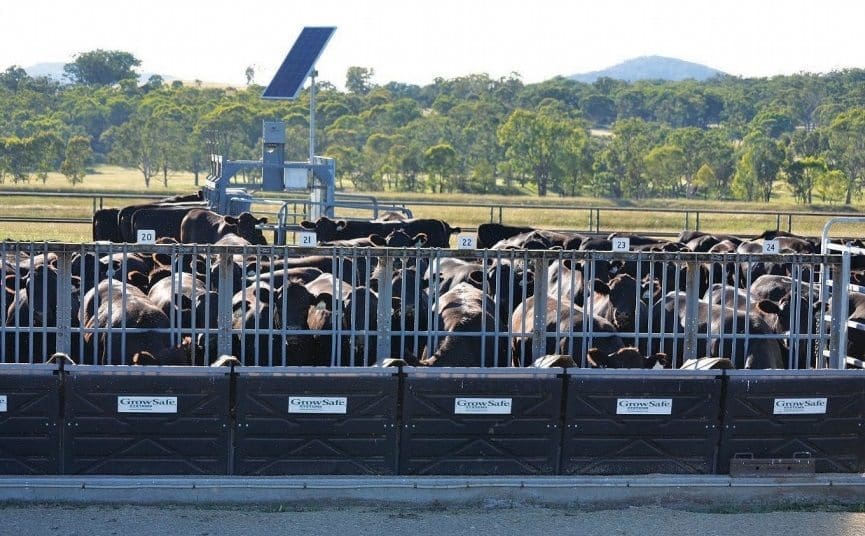
Feed intake collection on steers using the GrowSafe system at Tullimba Feedlot, Kingstown, NSW.
IN the past, the measurements of feed efficiency for cattle have been largely carried out at research facilities such as the Trangie Research station or the University of New England’s Tullimba research feedlot.
On-farm feed intake measurements needed to be submitted to the Trangie Research Centre to check for quality before submission to breed society databases.
The availability of the more modern ‘GrowSafe’ feed intake measuring equipment where all of the intake data is collected and analysed by the Growsafe company has meant there has been a change in the protocol for collection and submission of feed intake measurements for BreedPlan analysis, Southern beef Technology Services says.
The new protocol is outlined in the Tip Sheet – ‘Collecting Feed Intake Information for BreedPlan for post weaning and finishing tests’ which is available from the technical section of the BreedPlan website.
This Tip Sheet provides detailed information on the procedures for measuring feed intake including a schedule for the weighing of animals and a detailed description of how to conduct the feed intake measurements and submit the results.
Why Collect Feed Intake Information?
Feed efficiency is recognised as one of the most economically important production traits, both in grazing enterprises and feedlot operations.
Research has shown that significant variation exists in feed intake and feed efficiency between animals, and that a proportion of this variation is due to genetic differences. Obtaining feed intake measurements for the generation of NFI EBVs calculated within BreedPlan provides a valuable source of information when attempting to identify animals with superior genetics for feed efficiency to use in a beef breeding program.
Feed intake and weight data is analysed in BreedPlan to produce two Net Feed Intake EBVs being:
- Net Feed Intake- Feedlot Finishing EBV (NFI-F EBV): This EBV is an estimate of genetic differences between animals in feed intake at a standard weight and rate of weight gain when animals are in a feedlot finishing phase.
- Net Feed Intake – Post Weaning EBV (NFI-P EBV): This EBV is an estimate of genetic differences between animals in feed intake at a standard weight and rate of weight gain when animals are also in a feedlot but in a younger growing stage, immediately after weaning.
In both cases, NFI EBVs are expressed as kilograms (kg) of feed intake per day. Lower, or more negative, NFI EBVs are more favourable. For example, a bull with a NFI-F EBV of –0.6 kg/ day would be expected to produce progeny that consume less feed per day than the progeny from a bull that has a NFI-F EBV of +0.8 kg/day (when the progeny are of similar weight, are growing at a similar rate, and are in a feedlot finishing phase).
While there is a positive relationship between the two EBVs, some animals will rank differently for feed efficiency in the two different scenarios.
How much effort is involved?
Seedstock breeders who are considering collecting feed intake information for BreedPlan need to be aware that it can be challenging, expensive, time consuming and must be collected in a standardised way. However if effective feed intake information can be collected and analysed through BreedPlan, the economic benefits from a selection perspective can be considerable.
Where and how can I collect feed intake on my animals?
Feed Intake collection can be conducted either ‘on-farm’, or at a ‘central-test’ facility (e.g. Tullimba Feedlot, Kingstown, NSW). Commercial feeding systems that automatically record feed intake of individually electronically identified animals are recommended.
Currently most feed intake data is collected using the GrowSafe system (See http://www.growsafe.com/our-systems/feed-intake/) however there are other systems such as the Calan Broadbent Feeding System that can effectively capture feed intake data.
The recommendations and requirements that follow apply to all testing locations and systems.
What Animals Should Be Tested for Feed Intake?
- Animals must be between 210 and 700 days of age at commencement of the test.
- Bulls, steers or heifers can be tested. Sexes should not be mixed in the same pen.
- Animals should be tested in contemporary groups (i.e. animals of the same sex which are born within an individual herd in a 60 day period) to ensure that comparisons are made between animals which have been run under identical conditions, both before and during the feed intake test.
- The animals must be recorded with the breed society/BreedPlan prior to the start of the test and it is strongly recommended that they have at least a 200 Day weight recorded which includes management group information
- Animals that are in small or single animal contemporary groups prior to the test (e.g. Twins, sick animals) should not be included.
- For effective sire comparisons it is recommended to have a minimum of five progeny per sire with at least two sires represented.
- The largest practical number of animals in a contemporary group representing the progeny of more than one sire is recommended as it will provide more comparative information per animal.
- If it is necessary to split a large contemporary group for the feed intake test (e.g. due to pen size) then it is important that each sires progeny are equally represented in each subgroup. For example, if a contemporary group of 120 steers’ needs to be split into 3 sub-groups due to the pen size of 40 head then 1/3 of the progeny of each sire should be randomly selected for each sub-group.
Further information can be found in the ‘Collecting Feed Intake Information for BreedPlan for Post Weaning and Finishing Tests’ Tip Sheet which is available on the BreedPlan website.
